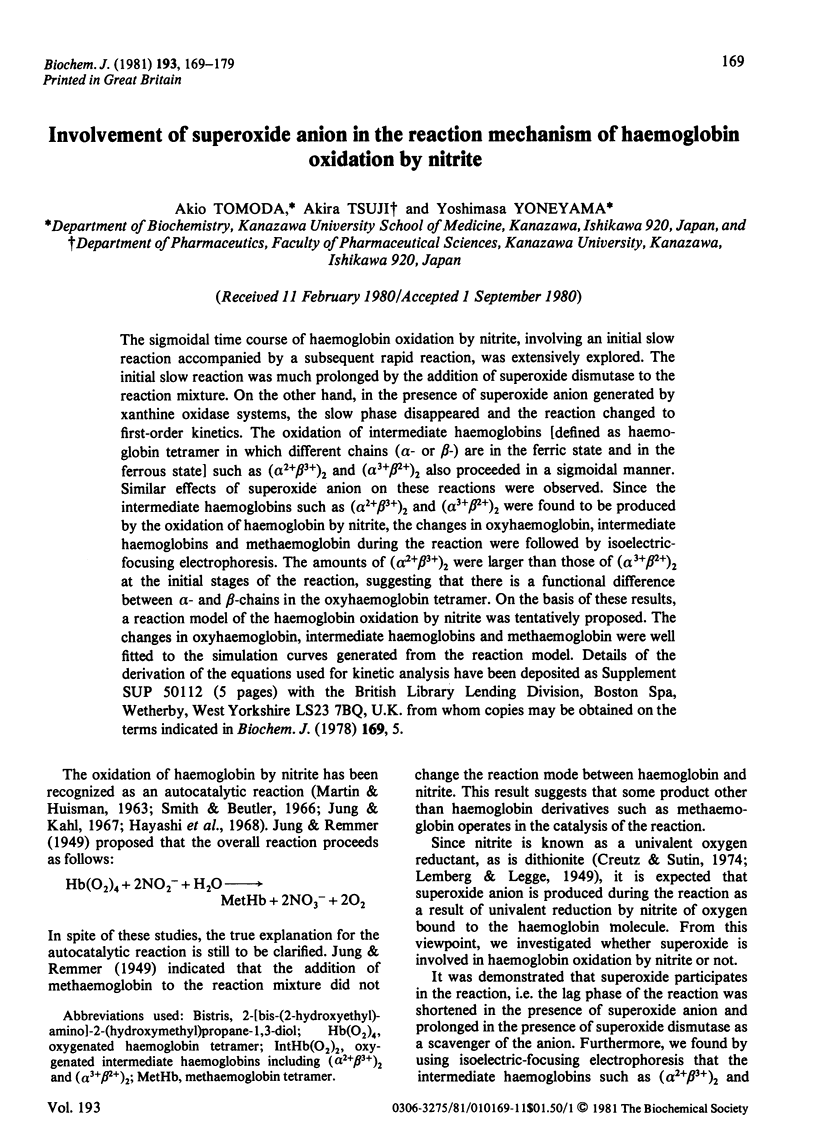Abstract
The sigmoidal time course of haemoglobin oxidation by nitrite, involving an initial slow reaction accompanied by a subsequent rapid reaction, was extensively explored. The initial slow reaction was much prolonged by the addition of superoxide dismutase to the reaction mixture. On the other hand, in the presence of superoxide anion generated by xanthine oxidase systems, the slow phase disappeared and the reaction changed to first-order kinetics. The oxidation of intermediate haemoglobins [defined as haemoglobin tetramer in which different chains (alpha- or beta-) are in the ferric state and in the ferrous state] such as (alpha 2+ beta 3+)2 and (alpha 3+ beta 2+)2 also proceeded in a sigmoidal manner. Similar effects of superoxide anion on these reactions were observed. Since the intermediate haemoglobins such as (alpha 2+ beta 3+)2 and (alpha 3+ beta 2+)2 were found to be produced by the oxidation of haemoglobin by nitrite, the changes in oxyhaemoglobin, intermediate haemoglobins and methaemoglobin during the reaction were followed by isoelectric-focusing electrophoresis. The amounts of (alpha 2+ beta 3+)2 were larger than those of (alpha 3+ beta 2+)2 at the initial stages of the reaction, suggesting that there is a functional difference between alpha- and beta-chains in the oxyhaemoglobin tetramer. On the basis of these results, a reaction model of the haemoglobin oxidation by nitrite was tentatively proposed. The changes in oxyhaemoglobin, intermediate haemoglobins and methaemoglobin were well fitted to the simulation curves generated from the reaction model. Details of the derivation of the equations used for kinetic analysis have been deposited as Supplement SUP 50112 (5 pages) with the British Library Lending Division, Boston Spa, Wetherby, West Yorkshire LS23 7BQ, U.K. from whom copies may be obtained on the terms indicated in Biochem. J. (1978) 169, 5.
Full text
PDF










Images in this article
Selected References
These references are in PubMed. This may not be the complete list of references from this article.
- Bunn H. F., Drysdale J. W. The separation of partially oxidized hemoglobins. Biochim Biophys Acta. 1971 Jan 19;229(1):51–57. doi: 10.1016/0005-2795(71)90316-3. [DOI] [PubMed] [Google Scholar]
- Hayashi A., Suzuki T., Shimizu A., Yamamura Y. Properties of hemoglobin M. Unequivalent nature of the alpha and beta subunits in the hemoglobin molecule. Biochim Biophys Acta. 1968 Oct 21;168(2):262–273. doi: 10.1016/0005-2795(68)90149-9. [DOI] [PubMed] [Google Scholar]
- Jung F., Kahl R. Uber die Reaktion zwischen Hämoglobin und Natriumnitrit. 3. Wasserstoffionenbilanz. Acta Biol Med Ger. 1969;23(4):603–608. [PubMed] [Google Scholar]
- Jung F., Kahl R. Uber die Reaktion zwischen Hämoglobin und Natriumnitrit. Acta Biol Med Ger. 1967;19(6):853–868. [PubMed] [Google Scholar]
- KEILIN D., HARTREE E. F. Purification of horse-radish peroxidase and comparison of its properties with those of catalase and methaemoglobin. Biochem J. 1951 Jun;49(1):88–104. doi: 10.1042/bj0490088. [DOI] [PMC free article] [PubMed] [Google Scholar]
- Kosaka H., Imaizumi K., Imai K., Tyuma I. Stoichiometry of the reaction of oxyhemoglobin with nitrite. Biochim Biophys Acta. 1979 Nov 23;581(1):184–188. doi: 10.1016/0005-2795(79)90235-6. [DOI] [PubMed] [Google Scholar]
- MARTIN H., HUISMAN T. H. FORMATION OF FERRIHAEMOGLOBIN OF ISOLATED HUMAN HAEMOGLOBIN TYPES BY SODIUM NITRITE. Nature. 1963 Nov 30;200:898–899. doi: 10.1038/200898a0. [DOI] [PubMed] [Google Scholar]
- Olson J. S., Andersen M. E., Gibson Q. H. The dissociation of the first oxygen molecule from some mammalian oxyhemoglobins. J Biol Chem. 1971 Oct 10;246(19):5919–5923. [PubMed] [Google Scholar]
- REIN H., RISTAU O., JUNG F. UBER DEN NACHWEIS VON NITROSOHAEMOGLOBIN MIT DER ELEKTRONENSPINRESONANZ BEI DER INTRAZELLULAEREN OXYDATION DES HAEMOGLOBINS MIT NATRIUMNITRIT. Folia Haematol Int Mag Klin Morphol Blutforsch. 1964;82:191–205. [PubMed] [Google Scholar]
- Smith J. E., Beutler E. Methemoglobin formation and reduction in man and various animal species. Am J Physiol. 1966 Feb;210(2):347–350. doi: 10.1152/ajplegacy.1966.210.2.347. [DOI] [PubMed] [Google Scholar]
- Tomoda A., Yoneyama Y. Analysis of intermediate hemoglobins in solutions of hemoglobin partially oxidized with ferricyanide. Biochim Biophys Acta. 1979 Nov 23;581(1):128–135. doi: 10.1016/0005-2795(79)90229-0. [DOI] [PubMed] [Google Scholar]
- Tomoda A., Yubisui T., Tsuji A., Yoneyama Y. Kinetic studies on methemoglobin reduction by human red cell NADH cytochrome b5 reductase. J Biol Chem. 1979 Apr 25;254(8):3119–3123. [PubMed] [Google Scholar]
- Tomoda A., Yubisui T., Tsuji A., Yoneyama Y. Kinetic studies on methemoglobin reduction by human red cell NADH cytochrome b5 reductase. J Biol Chem. 1979 Apr 25;254(8):3119–3123. [PubMed] [Google Scholar]
- Wallace W. J., Caughey W. S. Mechanism for the autoxidation of hemoglobin by phenols, nitrite and "oxidant" drugs. Peroxide formation by one electron donation to bound dioxygen. Biochem Biophys Res Commun. 1975 Feb 3;62(3):561–567. doi: 10.1016/0006-291x(75)90435-0. [DOI] [PubMed] [Google Scholar]



